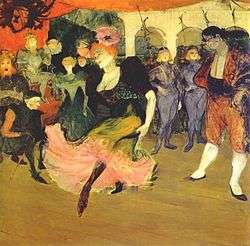Bolero (Spanish dance)
The bolero is a 3/4 dance[2] that originated in Spain in the late 18th century, a combination of the contradanza and the sevillana.[3] Dancer Sebastiano Carezo is credited with inventing the dance in 1780.[4] It is danced by either a soloist or a couple. It is in a moderately slow tempo and is performed to music which is sung and accompanied by castanets and guitars with lyrics of five to seven syllables in each of four lines per verse. It is in triple time and usually has a triplet on the second beat of each bar.

Relation to the Cuban bolero
The bolero, as a genre of music in Cuba, originated in Santiago de Cuba in the last quarter of the 19th century;[5] it does not owe its origin to the Spanish music and song of the same name.[6]
gollark: Inbreeding is a time/space tradeoff!
gollark: https://dragcave.net/lineage/MpmwIFun with inbreeding!
gollark: I'll probably just end up with *no* SAltkins.
gollark: When does christmas start?
gollark: *can't tell if complex but planned lineage or mad mess*
References
- Blatter, Alfred 2007. Revisiting music theory: a guide to the practice, p. 28, ISBN 0-415-97440-2.
- (see Time signature and meter (music))
- Morales, p. 120.
- Journal of the American Musicological Society 24, (Autumn, 1971), p. 480.
- Cristobal Diaz offers 1885: "el bolero, creado aproximadamente para 1885". Diaz Ayala, Cristobal 1999. Cuando sali de la Habana 1898-1997: cien años de música cubana por el mundo. 3rd ed, Cubanacán, San Juan P.R. p. 24–25.
- Carpentier, Alejo 2001 [1945]. Music in Cuba. Minneapolis, MN.
This article is issued from Wikipedia. The text is licensed under Creative Commons - Attribution - Sharealike. Additional terms may apply for the media files.